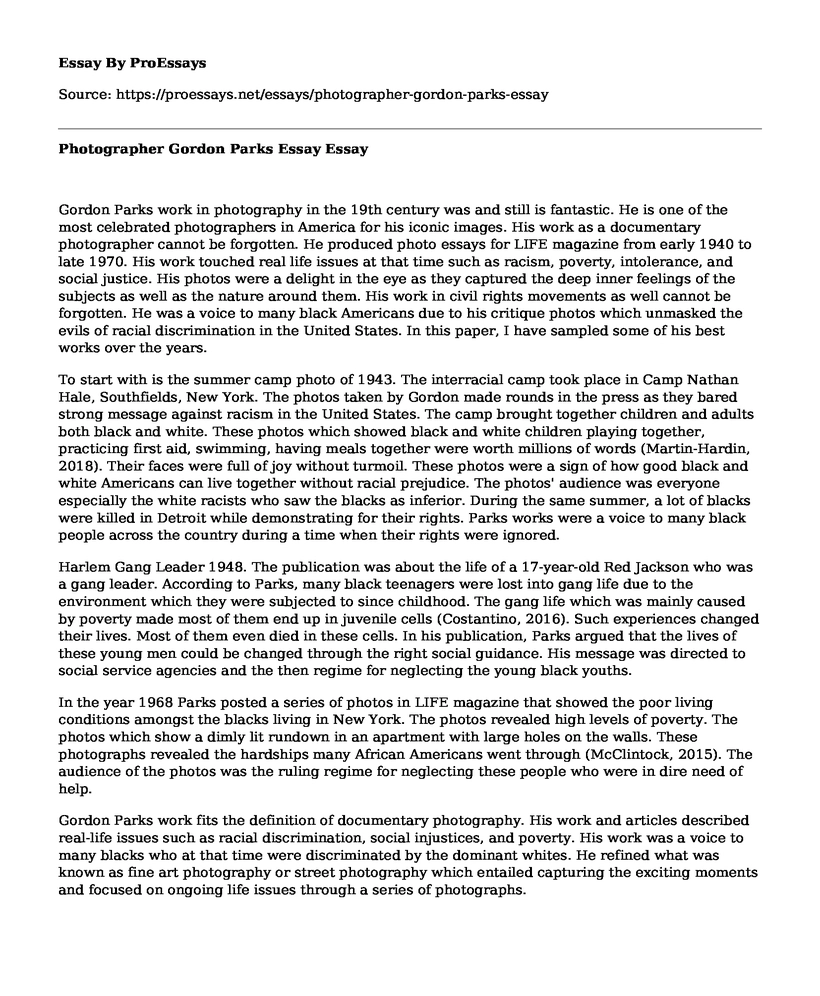Gordon Parks work in photography in the 19th century was and still is fantastic. He is one of the most celebrated photographers in America for his iconic images. His work as a documentary photographer cannot be forgotten. He produced photo essays for LIFE magazine from early 1940 to late 1970. His work touched real life issues at that time such as racism, poverty, intolerance, and social justice. His photos were a delight in the eye as they captured the deep inner feelings of the subjects as well as the nature around them. His work in civil rights movements as well cannot be forgotten. He was a voice to many black Americans due to his critique photos which unmasked the evils of racial discrimination in the United States. In this paper, I have sampled some of his best works over the years.
To start with is the summer camp photo of 1943. The interracial camp took place in Camp Nathan Hale, Southfields, New York. The photos taken by Gordon made rounds in the press as they bared strong message against racism in the United States. The camp brought together children and adults both black and white. These photos which showed black and white children playing together, practicing first aid, swimming, having meals together were worth millions of words (Martin-Hardin, 2018). Their faces were full of joy without turmoil. These photos were a sign of how good black and white Americans can live together without racial prejudice. The photos' audience was everyone especially the white racists who saw the blacks as inferior. During the same summer, a lot of blacks were killed in Detroit while demonstrating for their rights. Parks works were a voice to many black people across the country during a time when their rights were ignored.
Harlem Gang Leader 1948. The publication was about the life of a 17-year-old Red Jackson who was a gang leader. According to Parks, many black teenagers were lost into gang life due to the environment which they were subjected to since childhood. The gang life which was mainly caused by poverty made most of them end up in juvenile cells (Costantino, 2016). Such experiences changed their lives. Most of them even died in these cells. In his publication, Parks argued that the lives of these young men could be changed through the right social guidance. His message was directed to social service agencies and the then regime for neglecting the young black youths.
In the year 1968 Parks posted a series of photos in LIFE magazine that showed the poor living conditions amongst the blacks living in New York. The photos revealed high levels of poverty. The photos which show a dimly lit rundown in an apartment with large holes on the walls. These photographs revealed the hardships many African Americans went through (McClintock, 2015). The audience of the photos was the ruling regime for neglecting these people who were in dire need of help.
Gordon Parks work fits the definition of documentary photography. His work and articles described real-life issues such as racial discrimination, social injustices, and poverty. His work was a voice to many blacks who at that time were discriminated by the dominant whites. He refined what was known as fine art photography or street photography which entailed capturing the exciting moments and focused on ongoing life issues through a series of photographs.
References
Costantino, J. (2016). Harlem in Furs: Race and Fashion in the Photography of Gordon Parks. Modernism/modernity, 23(4), 789-811.
Martin-Hardin, A. (2018). Nature in Black and White: Summer Camps and Racialized Landscapes in the Photography of Gordon Parks. Environmental History, 23(3), 594-605.
McClintock, D. (2015). Gordon Parks at Atlanta's High Museum of Art.
Cite this page
Photographer Gordon Parks Essay. (2022, Mar 09). Retrieved from https://proessays.net/essays/photographer-gordon-parks-essay
If you are the original author of this essay and no longer wish to have it published on the ProEssays website, please click below to request its removal:
- The Scream by Edvard Munch
- Essay on Lysistrata in Both the Play Lysistrata and the Movie Chi-Raq
- "A Worn Path" Analysis Essay
- The Importance of Appearance and Appearance in "Phantom of the Opera" Paper Example
- Music Across Eras: How Tech, Social, Political, and Hist. Influences Shaped Different Styles - Essay Sample
- Movie Analysis Essay on Central Park Five
- What About Bob? A Comedy of Phobias and Egos - Essay Sample







